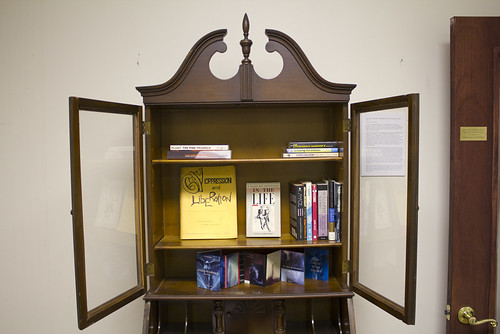
The Pop Up Museum of Queer History opened at the William Way Center until May 19.
The Pop Up Museum of Queer History is a grassroots organization intended to tell the unknown GLBT history of different communities.
Currently showing at the William Way Community Center, the Philadelphia exhibit explores the city’s contribution to the GLBT movement locally and nationally. From archived photographs, to sculptures to old memorabilia, the museum shows a wide variety of pieces that capture different aspects of Philadelphia’s GLBT community.
With two prior exhibits in New York and one in Bloomington, Ind., Philadelphia’s Pop Up Museum appeared to have a more local appeal.
“They’ve done it in New York before, except the Philadelphia one was more about Philadelphia [GLBT] history,” Bob Skiba, an archivist at William Way and the president of the Association of Philadelphia Tour Guides, said.
“We have a lot more sense of straight history, too. I know what kind of sense of history Philadelphia has: We have the Liberty Bell here, we have Independence Hall where our country was born, the first capital… so Philadelphians have a unique sense of history.”
Skiba contributed photos from his own archive featuring the history of Philadelphia Mummers in the exhibit.
Other pieces focusing on Philadelphia’s GLBT history are a map pinpointing the city’s black gay bars from the 1950s to the 1990s, photos of Philadelphia’s black GLBT social scene contributed by the Black LGBT Archivists Society of Philadelphia and the writing desk of Joseph Beam, a Philadelphia-based author and gay rights activist.
“I don’t even live in Philadelphia actually, I’m somewhat accidentally here but when I heard that this was happening and that Joseph Beam’s desk was here I was like, ‘Oh, I need to see it. That must be why I’m in Philadelphia for a day,’” said Alexis Gumbs, who was visiting from North Carolina.
“Sitting at this desk is a profound experience for me because I feel like there’s energy,” she added. “A desk where somebody sits and writes there’s energy in that space, and he was one of my favorite writers – that’s a huge deal in terms of contemporary black feminist ancestor worship for me.”
Beam’s desk was filled with GLBT related literature such as Beam’s anthology “In the Life” and “Brother to Brother.” The desk also featured copies of “Queer Histories: A Comic Book of Illustrated Oral Histories,” which gave personal accounts from different GLBT people and attracted readers visiting the exhibit.
“I think Philadelphia has a particular, very interesting, rich history in so many different ways, but the LGBT history here is kind of mind blowing [and] about both public and private spaces,” said Luce Capco Lincoln, a contributor to the exhibit, who also holds an MFA from Temple’s film and media arts program. “Part of what I think becomes really interesting is seeing all these photographs and exhibits, you see how private spaces were made public spaces.”
Some of the pieces gave the exhibit a more personal touch.
“You have these photographs of peoples’ homes being opened up and I think that’s pretty common across the country, but what I think is amazing to Philadelphia is sort of how, for instance, Joseph Beam is an amazing historical figure and who he was in conversation is because he was in Philadelphia,” she added.
Lincoln’s contribution was in collaboration with artist Che Gossett. Together, they did a mixed media piece combining photos of gay rights demonstrations with audio from activist Kiyoshi Kuromiya detailing his own personal history with being born in a Japanese internment camp, coming out and living with AIDS.
“The piece we did on [Kuromiya], he’s really important in Philadelphia history, but he’s also a really interesting icon outside of Philadelphia LGBT history in that he was one of the first people to start the gay liberation front here, he was involved with a lot of other things and there was a lot of intersectional work happening,” Lincoln said. “It’s not just what we imagine queer history to be, which is often when you think of the Gayborhood you think of white, gay men. I think it’s really important to think about it a lot larger than that.”
“The film that Luce and Che made was actually really incredible,” Gumbs said. “Understanding activism in a different way, learning about Philadelphia – because I’m not from Philadelphia – and how they responded to these national and international movements was really cool.”
Gumbs added that she had recently heard about a Pop Up Queer History exhibit in progress in her native Durham, N.C.
“I’m really excited about [the exhibit],” Gumbs said. “Seeing an exhibit like this really gives me an idea of what’s possible and there are so many different approaches you can take with that.”
Other creative pieces are also featured like “Chapel for the Betrayed,” a makeshift chapel covered in text from Uganda’s proposed anti-gay law, and “The Untitled Black Lesbian Elder Project,” a documentary on black lesbians featuring women from their 60s, 70s and 80s from all across the U.S.
“I feel like I learned all kinds of new things, but for me [with] exhibits like this learning is one part of it but I get that feeling of inspiration [that makes me want to] hang out in the archives of William Way and look through people’s boxes,” Lincoln said.
Luis Fernando Rodriguez can be reached at luis.rodriguez@temple.edu.



Be the first to comment